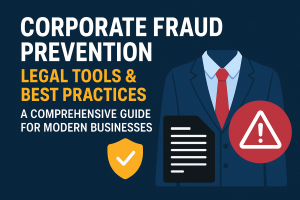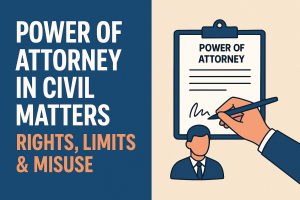In the realm of criminal justice, forensic evidence plays an increasingly pivotal role in solving crimes and aiding convictions. Thanks to the popular portrayal of forensics in films and TV shows like CSI and NCIS, the general public has developed a perception that forensic science can easily crack any case with precision and finality. However, reality diverges from fiction in many crucial ways. This blog aims to break down the myths versus reality of forensic evidence in criminal trials in India and explain how legal professionals can guide through the complexity of this domain.
What is Forensic Evidence?
Forensic evidence refers to scientific tests or techniques used in the investigation of crimes. It includes evidence like:
- DNA analysis
- Fingerprints
- Ballistics
- Toxicology reports
- Bloodstain pattern analysis
- Digital forensics (emails, chats, metadata, etc.)
- Handwriting and document examination
Such evidence is often presented in court to establish facts or disprove the claims of either party.
Legal Framework Governing Forensic Evidence in India
1. Bharatiya Sakshya Adhiniyam (BSA)
- Section 39: Recognises the opinion of experts in matters of science, including forensics, as relevant.
- Section 40: Allows the court to form its own opinion based on expert opinion, but such evidence is not binding.
- Section 329 BNSS : Allows reports of certain Government Scientific Experts to be admitted directly in evidence.
2. Information Technology Act, 2000
- Under Section 65B of the Indian Evidence Act, introduced through amendments via the IT Act, electronic records are admissible in evidence if accompanied by a certificate.
3. Narcotic Drugs and Psychotropic Substances (NDPS) Act, 1985
- Forensic analysis is crucial in NDPS cases to verify the nature and content of the substance seized.
Common Myths vs. Reality
Myth 1: Forensic Evidence is Always Accurate and Conclusive
Reality: Forensic science is not infallible. Mistakes can occur due to human error, contamination, misinterpretation, or bias in analysis. Courts often weigh such evidence with caution and look for corroboration with other material facts.
Myth 2: DNA Evidence Solves Every Crime
Reality: DNA analysis is powerful, but it is only helpful when a usable sample is available and there’s a comparative sample to match it with. Further, it does not explain how or when DNA was collected.
Myth 3: Forensic Experts are Neutral and Objective
Reality: While forensic scientists strive to maintain objectivity, bias can still influence results—especially when the expert works closely with one party. That’s why courts often treat expert opinion as advisory, not conclusive.
Myth 4: Forensic Reports Cannot be Challenged
Reality: Forensic reports can be and often are challenged in cross-examination. Defense advocates frequently raise issues about the method, preservation of the chain of custody, or the credentials of the expert.
Myth 5: All Types of Forensic Evidence are Admissible
Reality: Evidence must meet admissibility standards under the Bharatiya Sakshya Adhiniyam (BSA). For instance, a DNA test without proper chain of custody or without certification under Section 63 (for electronic evidence) may be excluded.
Judicial Pronouncements on Forensic Evidence
- Selvi & Ors. v. State of Karnataka (2010) 7 SCC 263
The Supreme Court held that narco-analysis, polygraph, and brain mapping tests conducted without consent violate Article 20(3) (protection against self-incrimination). - State of Gujarat v. Kishanbhai (2014)
The Supreme Court emphasized the importance of meticulous collection and handling of forensic evidence by police and investigative authorities. - State of Himachal Pradesh v. Rajiv Jassi (2015)
The Court reiterated that expert evidence must be corroborated by circumstantial or direct evidence for it to be relied upon for conviction.
The Reality: Forensics as a Tool, Not a Verdict
While forensic evidence has the potential to add scientific certainty, it is not a standalone substitute for a complete investigation or legal procedure. Courts often remind that forensic opinion is just that—an opinion—which must be weighed alongside other evidence.
Its value largely depends on:
- The methodology used
- The expert’s credibility
- The procedural integrity of how the evidence was collected, preserved, and tested
How Advocates and Law Firms Can Help
Legal professionals play a critical role in navigating the complexities of forensic evidence:
- Scrutinising Forensic Reports:
Advocate analyse whether the expert opinion is methodologically sound, legally admissible, and beneficial or detrimental to the client’s case.
- Cross-Examination of Experts:
Skilled advocates challenge the validity, bias, or accuracy of the findings during trial, especially under Sections 142 and 143 of the Bharatiya Sakshya Adhiniyam (BSA).
- Ensuring Due Process:
Law firms ensure that chain of custody is properly maintained and that the evidence was collected in compliance with procedural law, failing which it can be excluded.
- Engaging Independent Experts:
Advocates may consult private forensic experts to offer second opinions, especially when the prosecution’s findings are dubious.
- Advisory in Digital Evidence Cases:
With the rise of cybercrimes, law firms assist in ensuring compliance with Section 65B, preparing proper certificates, and guiding clients on admissibility and defence strategy.
Conclusion: Law Meets Science, but with Caution
Forensic evidence is a powerful asset in the criminal justice system, but it must be used judiciously and scrutinised thoroughly. Myths about its infallibility can be dangerous and lead to miscarriages of justice if not tempered by a sound legal strategy.
An experienced advocate or law firm ensures that scientific evidence is not blindly accepted, but critically evaluated and used strategically in building or defending a case. From reviewing forensic documents to cross-examining experts, legal professionals ensure that your rights are vigorously protected and justice is fairly served.



